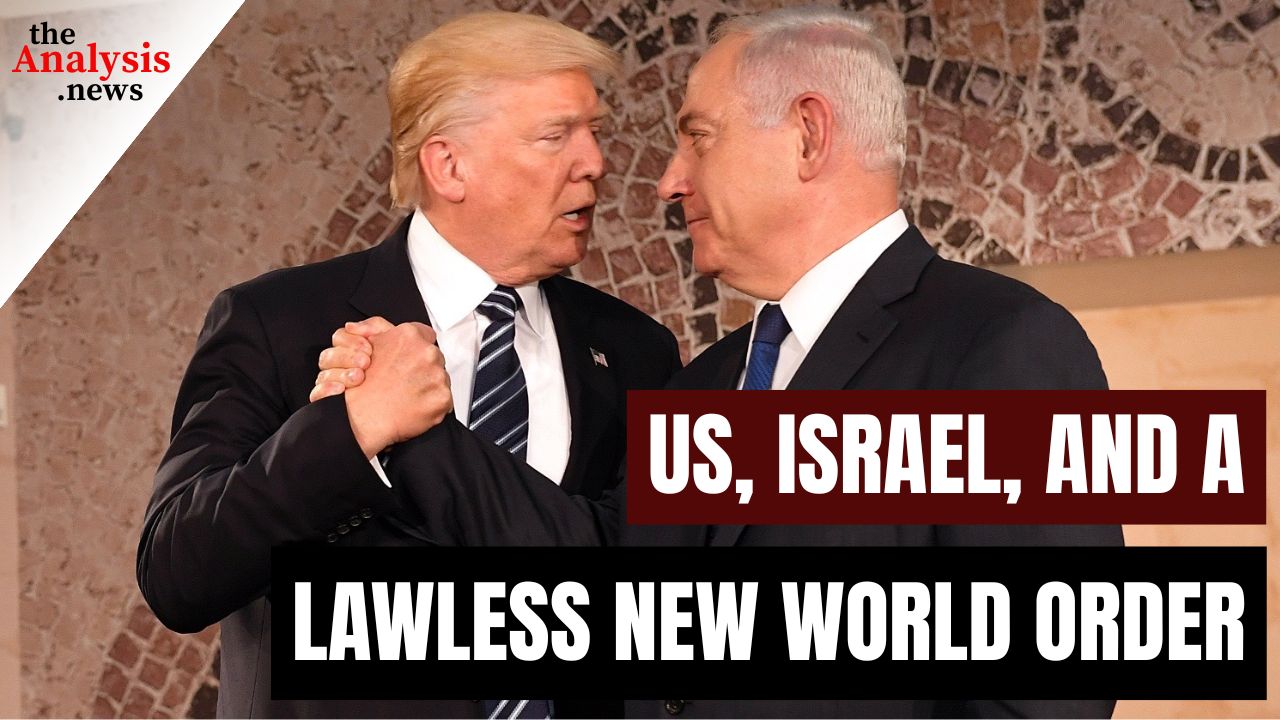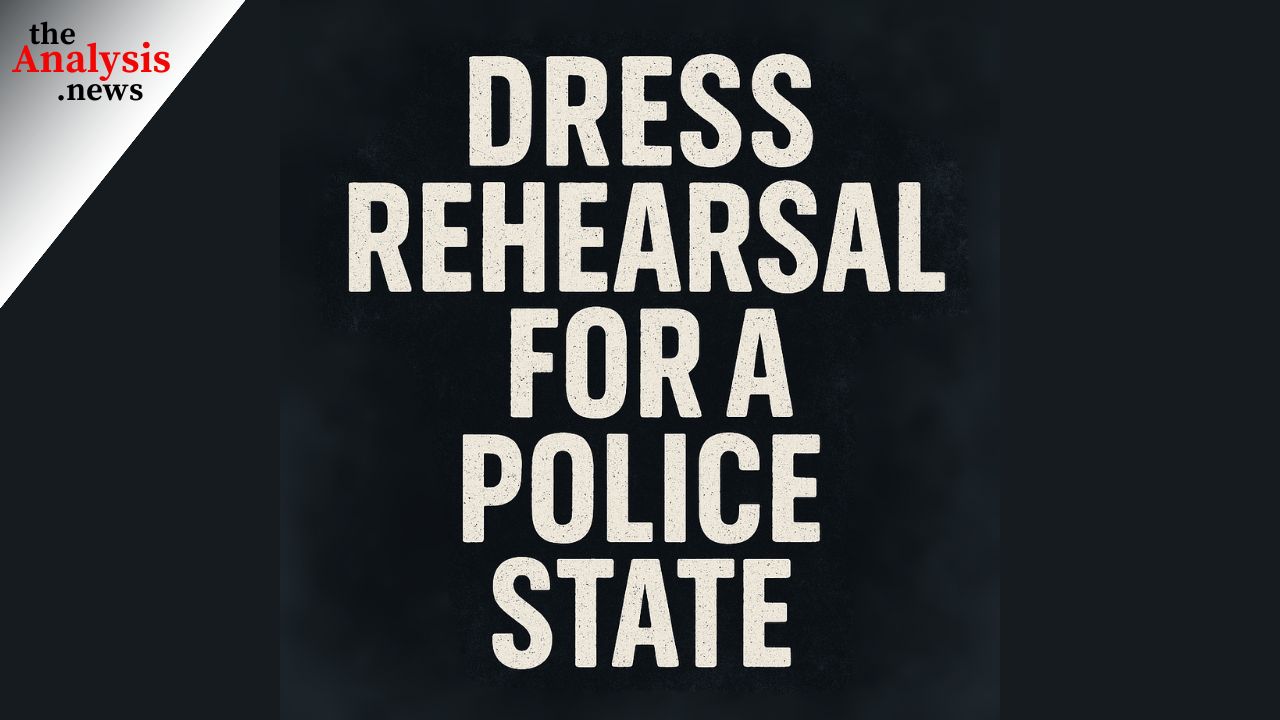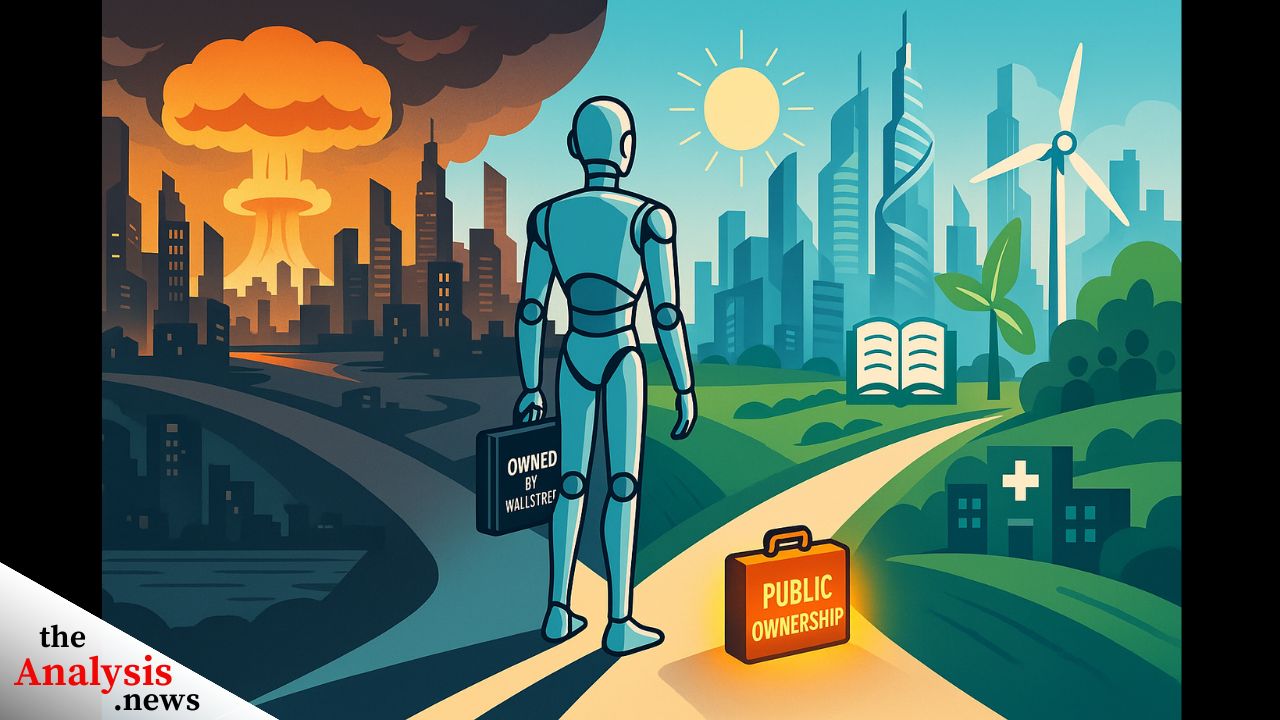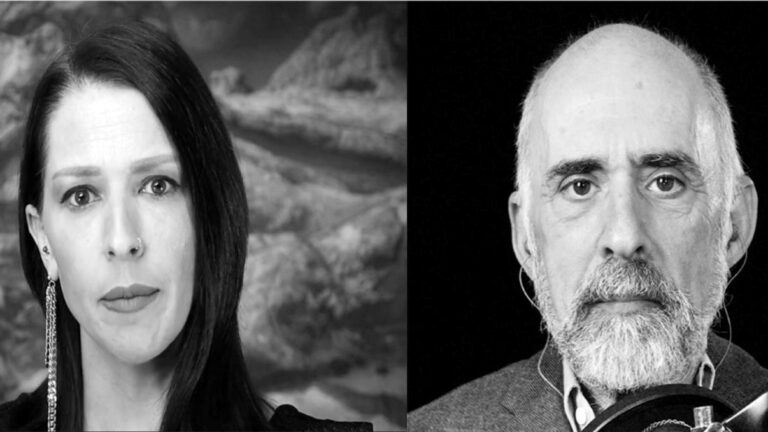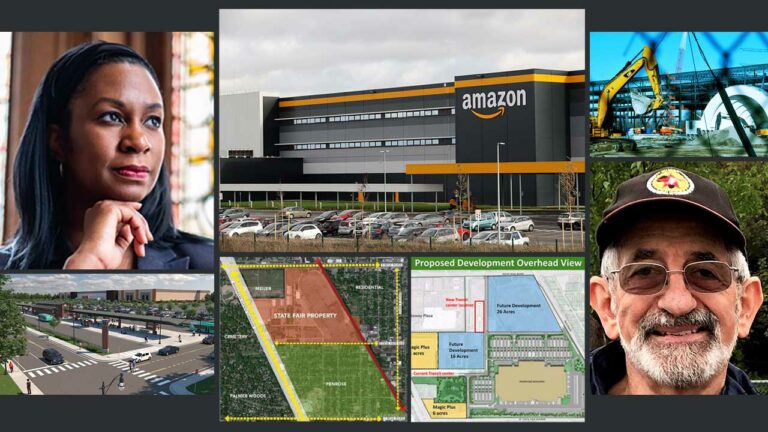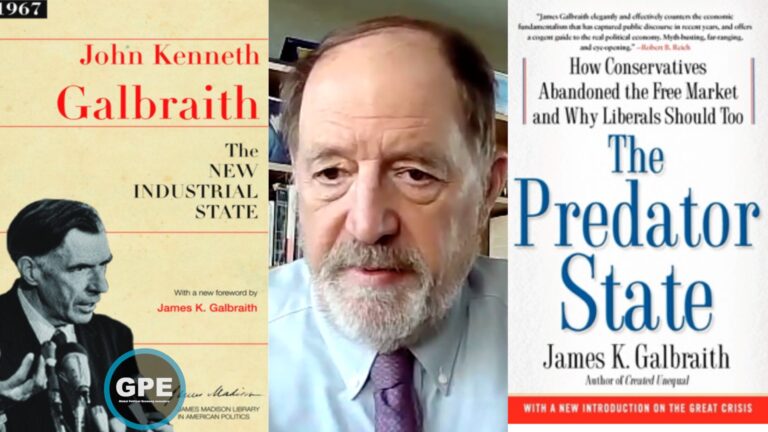In part two, Petra Molnar, anthropologist and human rights lawyer, speaks about the dangers of high-risk AI systems and state efforts to sabotage its regulation, as seen in the recent watering down of the European Union’s AI Act. Molnar explains how Israeli and U.S. surveillance tech firms market their drone technology and other AI products as “solutions” to state “problems.” The lucrative border and surveillance tech sector has grown exponentially as a result of governments deploying these technologies to experiment on the world’s most marginalized populations – from Palestinians in Gaza to migrants at the U.S. and EU’s deadliest land and sea borders.
AI Border Surveillance Tech Profits Soar, Human Rights Across the Board Sink – Petra Molnar Pt. 1/2
Talia Baroncelli
You’re watching theAnalysis.news, and I’m Talia Baroncelli. This is part two of my conversation with human rights lawyer and anthropologist Petra Molnar. We’ve been discussing her recent book, The Walls Have Eyes, and in this episode, we’ll get into the geopolitical implications of border and surveillance technology.
If you’ve been enjoying these episodes, feel free to go to our website, theAnalysis.news, and support us by hitting the donate button at the top right corner of the screen. Make sure you’re on our mailing list; that way, you’re always up to date every time we send out new content, and it gets sent straight to your inbox. You can also like and subscribe to this show on podcast streaming services such as Spotify and Apple or on our YouTube channel. See you in a bit with Petra Molnar.
Joining me now is Petra Molnar. She’s a human rights lawyer and anthropologist who co-runs the Refugee Law Lab at York University in Toronto. She also co-founded the Migration and Technology Monitor, which does work on human rights and technology. She’s the author of a new book called The Walls Have Eyes: Surviving Migration in the Age of Artificial Intelligence. Thanks so much for joining me today, Petra.
Petra Molnar
Thanks so much for having me.
Talia Baroncelli
I think one thing that became evident to me after reading your book is that the legal framework to deal with AI is a patchwork. It’s not coherent across the globe. In the United States, when you deal with, or in Canada, for example, when you deal with a lot of these high-risk technologies, it’s a completely different legal landscape. You were also involved in critiquing the European Union’s AI Act. I was wondering if you could shed some light on that because I think the AI Act’s provisions when it comes to high-risk systems are probably not enough to ensure that this erosion of rights doesn’t bleed over into other areas.
Petra Molnar
For those who are familiar with my work, you know that I’m a reluctant lawyer, but I’m still a lawyer, so I’ll put on my lawyer hat for a second. It’s an interesting time now to try and understand the governance mechanisms and lawmaking that are happening on technology, generally, and border tech, specifically. I think it’s fair to say that we don’t have a lot of laws, globally speaking and domestically speaking, to regulate really high-risk technology.
Again, that’s not an accident because it allows powerful actors to experiment, to innovate, to move fast and break things. That was a common slogan in Silicon Valley. Just introduce more and more technology without any guardrails.
Now, you mentioned the European Union’s AI Act. This was a really interesting opportunity to create a framework for governance of artificial intelligence. That’s hard to do, to be totally fair. We’re talking about an omnibus piece of lawmaking, this massive bill that tries to deal with all facets of AI, from toys to transport to border tech. That’s hard to do. It took many, many years. There was a coalition of us, academics, lawyers, and civil society, that tried to get the members of the European Parliament to think about what this tech is actually doing to real people, in our case, at the border. We were actually calling for some bans of some of the most high-risk uses of technology, whether that’s, for example, individualized risk assessments that use artificial intelligence or the use of predicted analytics for border decision-making and border interdictions, which are actually illegal under international law, and a few other of these amendments.
Unfortunately, but perhaps not surprisingly, none of these amendments made it in. Again, because migration is an incredibly politicized issue, it’s interesting because when you go into the text of the act, at first blush, you’re like, what is she talking about? There is a high-risk matrix in there that is used to determine what technologies are considered high-risk and what some of the protections need to be when we’re talking about these projects. Except when you look closely, you will see that there are a lot of exceptions or derogations under the act under national security. If a member state is able to say, “Well, but we need this project for national security,” none of those high-risk measures apply. Surprise, surprise, border tech, and national security are often conflated together.
The last thing I’ll say about the AI Act is, again, it’s a missed opportunity because it really could have set a global precedent on regulating AI, especially border tech. Because it didn’t do that, what incentive does the United States have to regulate Canada or Australia? I’m not saying that the European Union should have all this power to designate necessarily what we regulate, but it just sets a global conversation in motion that now again reaffirms that we don’t have a lot of guardrails or even a lot of conversations about a moratorium or a ban of some of the highest-risk technologies.
I don’t really know where this is going to go, to be honest, because the optimist in me says, well, the more people learn about it, the more conversations we’re going to have. But maybe the realist pessimist says we can’t even agree on autonomous weapons used in war and how to regulate those; what are the chances that we’re going to agree on some global agreement on border technologies? It’s not very likely. I think it’s definitely going to continue being this laboratory of experimentation because it’s also a very lucrative one.
Again, back to what we were saying before, because the private sector increasingly has the ear of governments, whether through lobbying in Brussels or, I mean, now, literally in the Oval Office with Musk, it’s not really likely that we’re going to see more regulation in the tech space at all.
Talia Baroncelli
Right. This also goes for a lot of the Israeli tech firms that are involved in developing surveillance and other technologies that can be used at the border, like Elbit Systems, for example, an Israeli company that developed drone technology and other technologies that are used even by Frontex, for example, the European Border and Coast Guard Agency in the European Union. Frontex uses drones made by Elbit Systems to surveil the Mediterranean and other parts of the E.U. borders. Of course, a lot of the weapons that Elbit makes are also used in the U.S. context.
How does this all line up? Because there are various issues that are involved here. It is obviously a politicized issue in using technologies made by an Israeli firm, which most probably have been first developed on Palestinians in the occupied territories. How does this ensure that there is a global hierarchy in place?
Petra Molnar
Yeah, and a global hierarchy that firmly places Israeli technology at the top. This is something that people like Antony Loewenstein, who’s a Jewish journalist, have been writing on for a long time. He published a book called The Palestine Laboratory, specifically on the Israeli testing of technologies on Palestinians and then exporting it out for other uses. I’ve been doing research on this, too, from the border perspective.
As you mentioned, there are Heron drones and Elbit drones that are flown around the Mediterranean and the GNC. There’s Elbit Systems, surveillance towers in the Sonora Desert, and that’s an Israeli company. So much of this technology is first tested out in Gaza and in the occupied West Bank.
I was in the West Bank in the spring of 2023, in places like Hebron and Ramallah and other places as well where a lot of this technology takes place. Seeing it firsthand, you realize the power of normalizing this omnipresent surveillance that’s first tested out on Palestinians and then exported out to the border. Geopolitically, too, we are seeing so much problematic decision-making around the normalization of tech because so many Western actors are afraid to take a stand on what is happening and what Israel is doing with the genocide in Gaza, also testing autonomous weapons on Palestinians there. It is this normalization of so much of this tech that, unfortunately, has its tendrils in so many other applications. It doesn’t just stay in Gaza or the occupied West Bank, but then it actually filters out into other spaces, too.
Talia Baroncelli
I wanted to ask you about the ways in which a lot of these securitized approaches to migration and what they call migration management are actually used as an extension of foreign policy. You write about this in your book, and Todd Miller, who I know is a colleague and friend of yours who wrote the book Emperor Borders, has also written about this in terms of how the U.S. Customs and Border Protection Officers are stationed around the globe to actually prevent migration to the United States. In this sense, they’re functioning as a tool of U.S. imperialism beyond the actual territory and jurisdiction of the United States.
We see this in the European Union context in which the European Coast Guard and Border Agency, Frontex, is stationed along the periphery of the European Union. In certain instances in Poland, for example, which you wrote about, they’re actually screening and ensuring that only Ukrainians are allowed in and allowed the right to asylum. They can move to whichever country they want within the European Union to get protection. Whereas certain people, such as Afghans or Syrians, who are also escaping conflict, are not afforded the same right, even though the right to asylum is actually for everyone. But there’s been a derogation away from those laws in favor of, in this case, Ukrainians over other people. Could you speak about the way that these policies are used as an extension of imperialism and foreign policy?
Petra Molnar
This goes back to those logics that we were talking about, that underpin who is welcome, who is seen as a “worthy refugee,” and which populations are again rendered as threats, frauds, and terrorists. So much of this breaks down along racial lines and the projects of empire and white supremacy that Todd Miller writes about, as also Harsha Walia and my colleague Tendayi Achiume. These racial logics need to be paid attention to in terms of how we even conceptualize a person on the move who is welcome versus someone who is not.
I’m glad that you mentioned the Polish-Belarusian border situation because I think this really brought it to light in many ways. A few years ago, the Belarusian Lukashenko regime was essentially weaponizing migration as a way to get a bunch of sanctions lifted, sanctions that were imposed by the European Union. He essentially invited groups of asylum seekers to come to the Belarusian-Polish border and then make their way into the European Union through this forested corridor between Belarus and Poland. Of course, Poland then erected a no-go zone, militarized the border, used a lot of surveillance there that they learned about from Greece, interestingly enough, and essentially trapped hundreds of people in a freezing forest. It was this weaponization of migration on part of the Lukashenko regime, but also on part of Poland to say, these refugees are not welcome. A lot of them came from Iraqi Kurdistan, Syria, and Afghanistan.
Then, a few months later, when the full-scale occupation of Ukraine began, we saw a very different response, an essential open border policy, kilometers down at the Polish-Ukrainian border, where I was there with colleagues doing human rights monitoring. Having seen this massive shift from a few months ago at the Polish-Belarusian border, where it was securitized, militarized, and unwelcome, babies were dying in freezing forests. Then, on the other hand, Ukrainian refugees were allowed to come into the European Union with open arms, essentially. It again brought these logics of race exclusion into sharp focus.
I’m not saying that Ukrainian refugees should not have been welcome. I think that was wonderful. It just shows that it is all about these logics and constructions of who is welcome and who isn’t. It could have been a moment of hope as well because if it’s possible to do this for Ukrainian refugees, then it is possible to do it for other refugees, too. Although even with Ukrainian refugees, the tide has turned. Even a few months after people were coming into the European Union, there were already rumblings like, “Well, when are they going to go back?” Even the humanitarian space that opened up, perhaps similarly to what happened in 2015, 2016, when Syrian refugees were entering the European Union for the first time. Unfortunately, yeah, I think that space has shrunk, and unfortunately, migration has been weaponized again, even against Ukrainian refugees now.
Talia Baroncelli
There’s a part of your book, I think it was a chapter that’s called We Are Here Because You Were There. Can you explain that? I think it’s really powerful, but it’s very short. I think it represents a lot more in terms of history and migration. I was hoping that you could explain that to people.
Petra Molnar
Sure. I can’t take credit for this statement. This is something that has been said a lot by people in the global majority and people who are on the move themselves as a way to recognize that so much of human movement and migration is as a result, again, of Western imperialism, of conflict, of colonization. The reason why people are moving is, again, because of Western action.
There is this amnesia, I think, on the part of the European Union and the United States; this is almost like shock. Why are people coming? Well, it’s because of wars that have been perpetrated by the West for centuries, decades. I like this reframing because it also, I think, reintroduces agency, dignity, and choice on the part of mobile populations that are making their way westward, perhaps. It also has perhaps a reminder of the conversations that are being had about reparations. Does the West owe communities that have been disenfranchised historically, bombed out, and at the receiving end of environmental degradation, too, largely as a result of Western inaction on the global climate crisis as well, which also forces people to move?
I think it’s a great reminder of the responsibility of powerful actors to at least try and understand why people are coming and what are some of the root causes of migration. The root cause conversation is something that is just not being had. We are focusing on drones at the border, stronger border, migration management, more technology, and keeping people away rather than actually addressing the root causes of why people have to move.
If I can just share an anecdote, this is something I think is so simple, but a lot of people don’t think about it. I have heard this time and again from people who are on the move, but people don’t want to be refugees. That is not a choice that you would make willy-nilly or like, I’m just going to do this now. I’m not saying that people don’t have economic reasons to migrate as well. I think that it’s actually perfectly fine to have legitimate needs for asylum and also have economic reasons to move. We are all complex beings. But I think it’s a reminder that, again, people don’t want to be forced from their homes. If they could stay home, a lot of people would, right? But again, it goes back to the root causes of why people are having to move and why they are finding themselves in places that, again, are the places that are perhaps the reason why they had to move in the first place.
Talia Baroncelli
Well, could you speak about that a bit more? Because I think some people look at migration through a very narrow lens, maybe through a security lens or even just through a strict asylum lens. They don’t actually look at some of the broader hierarchies and forces that are involved. Based on the research that you’ve done in various parts of the globe, how would you say that migration is actually a product of a lot of global hierarchies but also strategies of capitalist accumulation and poverty and marginalization?
Petra Molnar
This is where the work of Harsha Walia comes to mind, and the great reporting that the Transnational Institute has been doing on this for years and years. Tying, for example, Western warmongering in spaces like sub-Saharan Africa to the creation of forced migration and profiting off of this, literally war profiteering. Then it rubs up against, again, these anxieties about keeping the border safe, preventing people from coming into the European Union. This is also where we see a lot of, the big word for it is externalization. But really, all that means is the European Union and the United States pushing their border further afield and using different types of tools, whether that is surveillance or training of border guards or basically any mechanism to prevent people from even reaching European territory. The border actually moves into North Africa or sub-Saharan Africa as a result. There’s this tension there because we see these largely Western forces creating a lot of the conflict or stoking a lot of the conflict, or at the very least, being willfully blind to things like environmental degradation. Then, strengthening the border regime, the exclusion, the externalization through tech, through policymaking, through deterrence. Yet just being so unprepared, I think, for the fact that more and more people are going to be migrating in the coming decades. That, I think, is a given. I’m not saying that to fearmonger, but I think that’s a fact of life now. It’s important to pay attention to how capital and, as you say, resource accumulation, extraction, also labor issues that come into this with the development of technology, which communities get tested on when it comes to technology; that all really comes back to this global story of who gets to benefit from being in the West, who gets to benefit from new technology, and which communities, again, are at the receiving end of all of this and relegated to the margins.
Talia Baroncelli
Do you think that with the climate crisis getting worse, the E.U. and the United States will continue to use these techno-solutionist approaches to deal with people who are fleeing due to economic or climate destruction?
Petra Molnar
Yeah, definitely. I don’t have a crystal ball, but that’s the trend that we’ve been noticing. Again, externalization, more technology, more surveillance, not even dealing with environmental degradation within the United States or within Europe, the massive flooding, the droughts, the forest fires that we are seeing. That’s going to stretch resources already, just domestically. Imagine the conversations that would need to be had about creating some international protection regime for people who are going to be fleeing environmental degradation.
Legally speaking, too, this is very much an open question because right now international refugee law does not recognize environmental refugees. There have been cases people have brought cases to different courts in New Zealand, for example, small island nations saying, “Well, we are flooding, and we’re going to not exist as a result of Western environmental degradation. We should be able to apply for refugee status and meet the refugee definition because of persecution because of environmental degradation.” It hasn’t gone. The jurisprudence has not moved forward that way, and it maybe never will.
There are competing conversations about whether that’s even the appropriate way to go, amending the refugee definition, or whether there maybe needs to be a whole new legal regime for people who are migrating as a result of environmental degradation. Maybe I’m biased because I work on this all the time, but I think this is the defining issue of our time, because it brings together conversations around migration and the environment, and it’s really going to come to a head. It already has in many ways, but we’re just going to see more and more of this in years to come.
Talia Baroncelli
One thing that was really interesting in your book is a lot of the companies that you’re talking about, these border and tech surveillance companies, a lot of them actually have private equity investors. Companies like Vanguard and State Street, those sorts of companies, I’m sure BlackRock is also involved, but those private equity companies are also heavily invested in Chevron and big oil and gas that are actually contributing to a lot of the environmental destruction that we see. In a way, it’s money laundering by contributing to the problem and then investing in the so-called solution to the problem.
Petra Molnar
Yeah, not to mention also the labor issues around major data centers that are oftentimes also, again, outside of Europe and the U.S., and also the environmental impacts of these massive server farms, for example. They’re generating so much heat, so much electricity. We don’t like to think that because we want the latest iPhone, we want the latest software update. All of this is predicated on these ways that power operates and is allowed to operate in specific spaces around the world as opposed to the other ones that are extracted from, whether it comes from human capital, labor, mobility, or all of that.
Talia Baroncelli
This is the final question. What do you see as the way to approach a lot of these invasive and aggressive technologies? Is it awareness as to their effects, or is it trying to put pressure on politicians to ensure that there’s maybe more robust legislation around these different high-risk systems? What would you say needs to be the way forward here?
Petra Molnar
Yeah, this is the stuff that keeps me up at night. I think awareness is definitely part of it, making sure that the public and policymakers really are aware of the effects of what this technology is already having on affected communities. This is not a theoretical conversation but rather a real-world example of violent technologies.
I think that maybe goes to my second point. I hope this doesn’t sound overly simplistic, but I think actually storytelling and story-driven narratives are a way forward because we need to humanize the people who are on the receiving end of these technological experiments. It’s not just a bunch of lawyers talking, but it’s actually about people’s experiences and expertise from the ground up that is fueling the conversations that we need to be having about what we innovate on and why. That’s what the book tries to do. It’s not that academic. It tries to tell people’s stories and share stories that I’ve been privileged to learn and to steward through, hopefully also as a way to humanize the issue a little bit so that, again, it’s not just a bunch of data, drones, or robodogs, but it’s real people on the move who are on the sharpest edges of innovation.
Talia Baroncelli
I actually do have one final question now that you mentioned that because there’s been this rightward shift in our politics, like the overton window has shifted, and that’s partly because of the failure of the center-left to actually identify what people really need and the issues and the needs of the working class. They’ve also pandered to a lot of the narratives that the right has been pushing.
The right is always talking about migration as a problem, but would you say that one way to combat that narrative is to give another alternative? That alternative being one that illustrates, and that’s one of solidarity, that illustrates the various inequalities that are global and the ways to actually combat that and to give something to people to hope for as opposed to seeing migrants and people on the move as someone to be scared of or people to be fearful of, and they’re taking our jobs, all of the disinformation that’s around that. What is the alternative in terms of policy to actually bring people together and point out that the enemy is not migration or migrants, but actually the rich elite who are trying to divide us?
Petra Molnar
Yeah, and the enemy are these policies and politics of difference. Pitting ourselves against each other in this system that’s actually hurting all of us in different ways but in similar ways. Absolutely, I think we need to find more togetherness. We have so much more in common with one another than we realize. I think politicians have become very good at the divide-and-conquer strategy. Instead, it is absolutely about creating spaces where we can learn from one another and learn from the things that affect all of us. I think that is a way forward that hopefully will also allow for creative world-making that is necessary to be had in this rather difficult time for a lot of people.
Talia Baroncelli
Petra Molnar, it’s been really illuminating speaking to you and also reading your book. I hope people read it, The Walls Have Eyes. Sorry about that reflection. It’s really a great book. Thanks again for joining us and hope to have you back soon.
Petra Molnar
Thanks so much for having me.
Talia Baroncelli
Thank you for watching theAnalysis.news. If you enjoyed that content, feel free to support us by going to theAnalysis.news. See you next time.
Podcast: Play in new window | Download | Embed
Subscribe Apple Podcasts | Spotify | Android | iHeartRadio | Blubrry | TuneIn | Deezer | RSS
Never miss another story
Subscribe to theAnalysis.news – Newsletter
Petra Molnar is a lawyer and anthropologist specializing in migration and human rights.
A former classical musician, she has been working in migrant justice since 2008, first as a settlement worker and community organizer, and now as a researcher and lawyer. She writes about digital border technologies, immigration detention, health and human rights, gender-based violence, as well as the politics of refugee, immigration, and international law.
Petra has worked all over the world including Jordan, Turkey, Philippines, Kenya, Colombia, Canada, Palestine, and various parts of Europe. She is the co-creator of the Migration and Technology Monitor, a collective of civil society, journalists, academics, and filmmakers interrogating technological experiments on people crossing borders. She is the Associate Director of the Refugee Law Lab at York University and a Faculty Associate (and former Fellow) at the Berkman Klein Center for Internet and Society at Harvard University. Petra’s first book, The Walls Have Eyes: Surviving Migration in The Age of Artificial Intelligence, is published with The New Press in 2024.

